
Intel just launched its 14th generation of Core processors, a series of desktop CPUs based on the same architecture as the previous 13th generation but with slightly higher clock speeds. Some models, like the Core i7-14700K, also come with more cores and threads. That’s not the case for the Intel Core i5-14600K CPU that I’m reviewing today. This processor is almost identical to its predecessor, the i5-13600K, but offers slightly faster frequencies. Is it a good choice for an upgrade or for a brand-new computer? Read on and find out what to expect from Intel’s latest mid-ranger, the Core i5-14600K:
Intel Core i5-14600K: Who is it good for?
This processor is a good choice if:
- You’re looking for a balanced and versatile desktop CPU that can offer excellent performance in various workloads
- You want a fast processor for gaming, first and foremost
- You’re upgrading from an Intel 12th Gen processor or older
Pros and cons
These are the positive aspects of the Intel Core i5-14600K:
- It’s fast and delivers excellent performance in games
- Overall, it’s faster than the AMD Ryzen 7 7700X
- Compatible with PCI Express 5.0
- It can work with either DDR5 or DDR4 memory
- Fair pricing for the level of performance you get
There are also a few downsides:
- It can draw a lot of power, and it’s a lot less energy efficient than its AMD rivals
- It’s not a good enough upgrade over 13th Gen Intel Core processors
- Doesn’t bundle a cooler
Verdict
The Intel Core i5-14600K processor is a mid-range CPU that offers excellent performance for gaming and does well in productivity tasks. In other words, the Intel Core i5-14600K is worth buying if you are looking for a balanced processor that can handle most games and applications without breaking your piggy bank. While it’s not the most powerful or the most efficient processor in the market, it offers good value for money. However, it’s a disappointing upgrade for the Intel Core i5-13600K, its predecessor, as the only change is a (very) tiny increase in frequencies. I recommend upgrading to this processor only if you’re using an older processor from the 12th Gen or earlier.
Unboxing the Intel Core i5-14600K
The Intel Core i5-14600K is one of the 14th generation processors from Intel, and it comes in a small blue cardboard box. The box has a minimalist design, letting you know only that this is an Intel Core i5 CPU. In the center of the sample box I received, there was a cutout through which I could see the actual processor and glimpse at its complete name: Core i5-14600K. However, in retail stores, the packaging might look different, possibly like in the picture below.
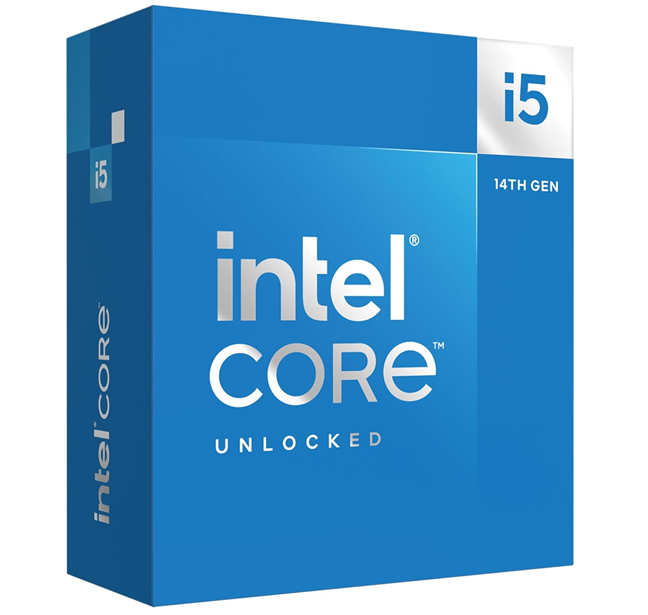
The box of the Intel Core i5-14600K processor
Inside the box that I received, I only found the Intel Core i5-14600K processor; nothing else was in there. However, this was a sample for tech reviewers and journalists. In a retail box, you should also find an installation manual and warranty details.
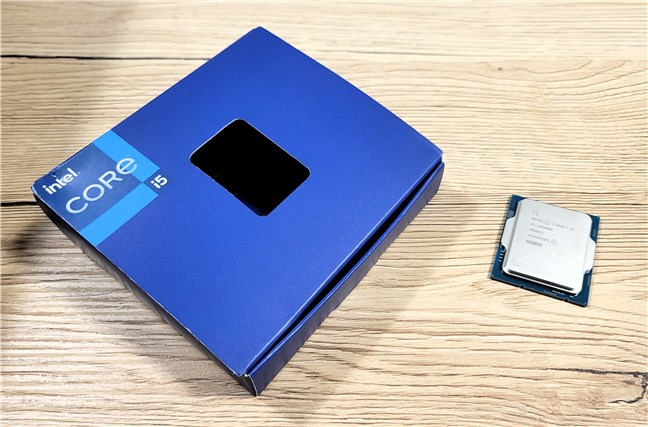
What's inside the box
The Intel Core i5-12600K processor comes in a simple package that only includes the essentials. This means you must buy a separate cooler for this CPU, as the company does not provide one. The unboxing process is fast and easy; you just need to open the box and remove the processor.
Hardware specifications
The i5-14600K is a mid-range desktop CPU from Intel’s 14th generation of Core processors. It’s based on the Raptor Lake Refresh architecture, which is more rather than less the same Raptor Lake architecture used by the 13th Gen Intel Core CPUs. The only, and barely noticeable, change between the two architectures is a tiny increase in frequencies and, in some processor models, the addition of a few more cores.
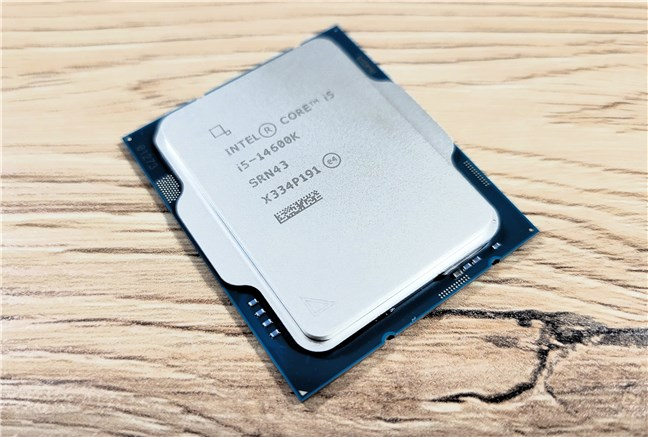
The Intel Core i5-14600K processor
In the case of the Intel Core i5-14600K, the CPU gets the same number of performance cores (P-cores optimized for high-intensity workloads) and the same number of efficiency cores (E-cores that handle the lighter tasks) as its predecessor, the Core i5-13600K.
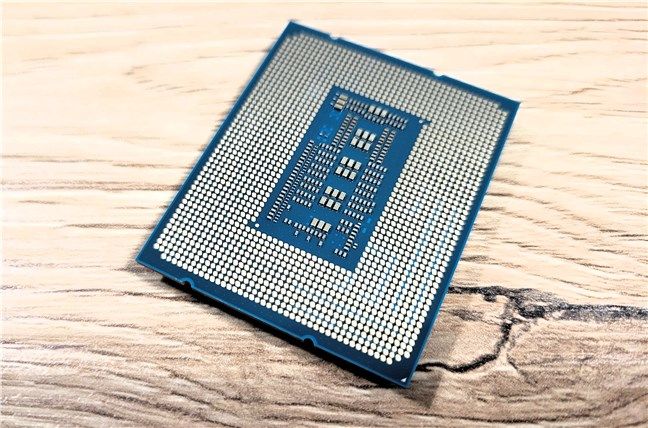
The contacts of the Intel Core i5-14600K processor
The Core i5-14600K has six P-cores that run at a base clock of 3.5 GHz and can reach 5.3 GHz, and eight E-cores running at a minimum frequency of 2.6 GHz and up to 4.0 GHz in boost mode. Compared to its forerunner, the P-cores on the Core i5-14600K can reach a maximum boost speed that’s 0.2 GHz higher. It’s a modest improvement, but the E-cores are even more humble, offering only a 0.1 GHz higher speed in boost mode.
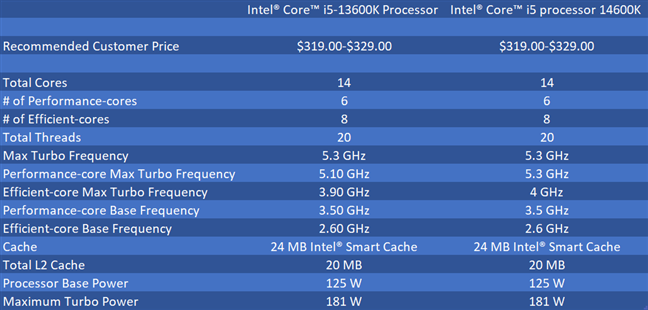
Intel Core i5-13600K versus Core i5-14600K
The processor’s six performance cores translate into 12 threads, while the eight E-cores mean 8 threads. The cache specs are identical to the Core i5-13600K model: Level 3 cache memory of 24 MB and Level 2 cache of 20 MB.
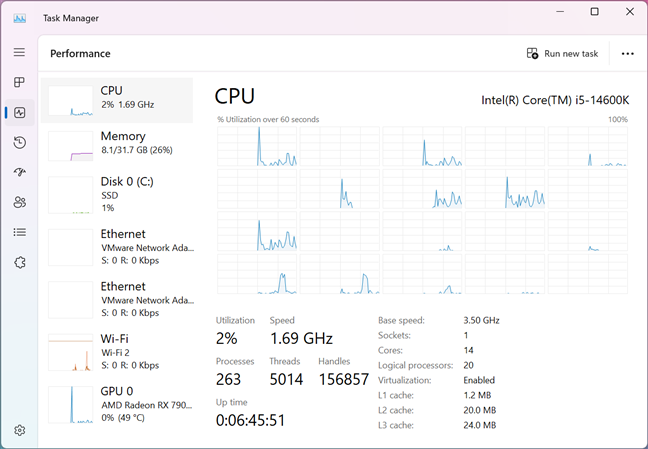
The Intel Core i5-14600K has 14 cores and 20 threads
The Intel Core i5-14600K supports both DDR5 and DDR4 memory and works on the same motherboards as its predecessor. You can choose the type of RAM that suits your needs and budget without compromising on performance. However, remember that you can’t mix and match different types of RAM on the same motherboard. You have to select one type of memory and stick with it.
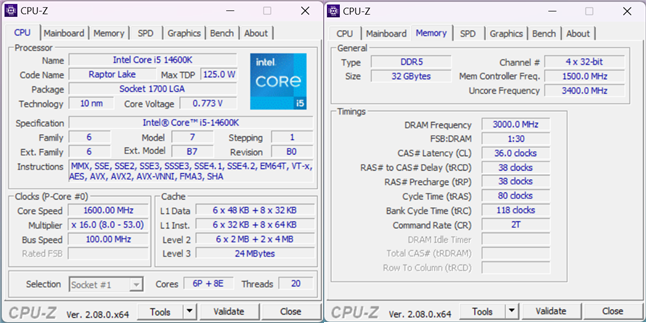
The specs of the Intel Core i5-14600K processor
Intel stopped providing the TDP (Thermal Design Power) values a while ago, giving us instead the base and max power consumption values. The PBP (Processor Base Power) for the Intel Core i5-14600K is 125 Watts, while the MTP (Maximum Turbo Power) can reach 181 Watts. Check at the end of the benchmarks section in this review to see the real maximum power consumption of this processor.
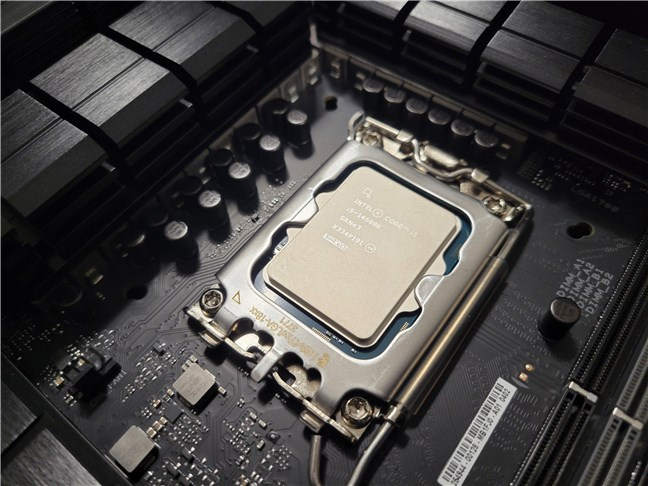
The Intel Core i5-14600K processor mounted on a motherboard
The Intel Core i5-14600K supports PCI Express 5.0 and 4.0, offering 20 PCIe lanes. These can be split into a 1x16+4 configuration or a 2x8+4 configuration. 1x16+4 means that 16 lanes go to a single PCIe slot for maximum graphics bandwidth, and 4 lanes go elsewhere (NVMe or PCIe slot). 2x8+4 means that two PCIe slots can get 8 lanes each, while a third gets 4 lanes.
The Intel Core i5-14600K desktop processor should deliver good performance in most scenarios, including gaming. However, it’s disappointing to see that it’s almost identical to its predecessor. Except for a very small boost in clocks, the i5-14600K is the same as the i5-13600K. I would expect minimal performance improvements compared to its forerunner.
Intel Core i5-14600K’s performance in benchmarks
Now, let’s see what the Intel Core i5-14600K can do in real life. I’ll go through a series of productivity benchmarks, show you how it performs in games, and, last but not least, I’ll tell you more about its cooling and power requirements.
Test system configuration
I tested the Intel Core i5-14600K processor on a desktop PC that had the following hardware and software:
- Motherboard: ASUS TUF Gaming Z790-Pro Wi-Fi
- Cooler: ASUS ROG Ryujin III 360 ARGB AIO
- Memory: Kingston Fury Beast RGB DDR5-6000 32GB
- Graphics Card: AMD Radeon RX 7900 XT
- Storage: Kingston KC3000 PCIe 4.0 NVMe M.2 SSD 2TB
- Monitor: ASUS ROG Strix XG32UQ (4K UHD)
- PSU: Seasonic Focus GX-1000
- Operating System: Windows 11 Pro Version 22H2
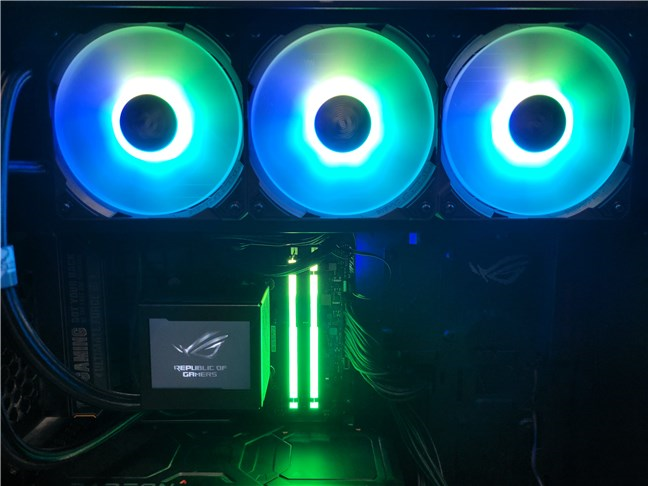
The desktop PC used for benchmarking
To get a clearer idea about the performance offered by the Intel Core i5-14600K, I compared its results with those I got from other desktop processors I previously reviewed, both from Intel and AMD.
Performance in productivity benchmarks
The Core i5-14600K offers top-notch single-thread performance. With a score of 867 points, the processor is way better than any of the AMD Ryzen 7000 series CPUs I’ve tested, including the higher-end Ryzen 9 7950X or 7900X. The Core i5-14600K beats the next one after it by 10.34%.
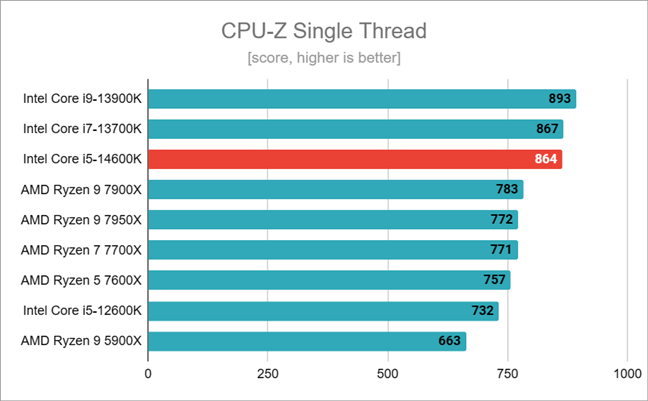
Benchmark results in CPU-Z Single Thread
The Intel Core i5-14600K showed good performance in the CPU-Z multi-thread test too, scoring 10060 points. It outperforms AMD’s mid-range proposition, the AMD Ryzen 7 7700X, but can’t match the performance of an AMD Ryzen 9 7900X or that of an Intel Core i7-13700K. Here, the number of cores matters.
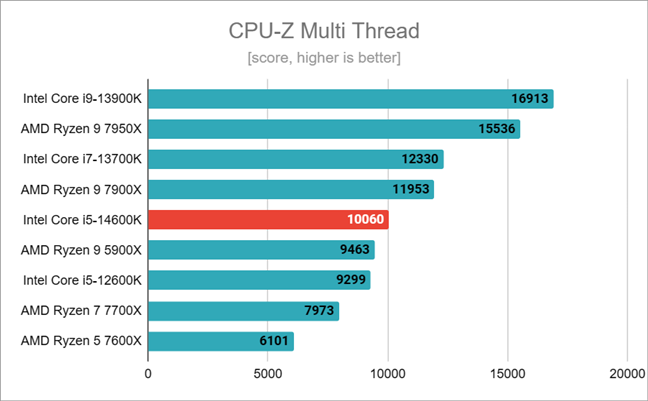
Benchmark results in CPU-Z Multi Thread
The Intel Core i5-14600K delivered a more than reasonable score (24150 points) in the Cinebench R23 rendering test. This result was far superior to the AMD Ryzen 7 7700X, which lagged behind by 24%. However, it was no match for the processors equipped with more physical cores.
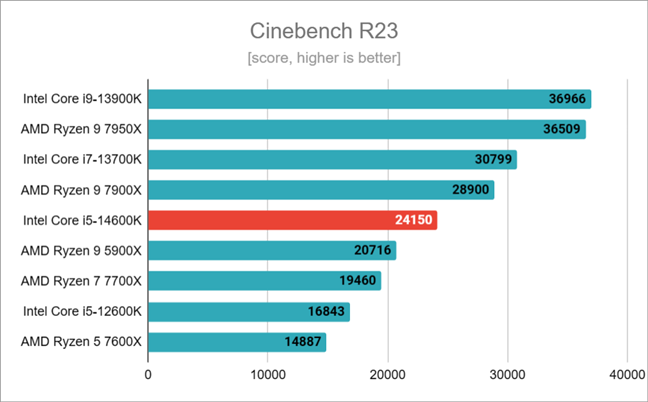
Benchmark results in Cinebench R23
The Intel Core i5-14600K also delivered good results in Blender, the second rendering benchmark I used to evaluate its performance. It managed to get 322 points, which is a decent score considering its specs.
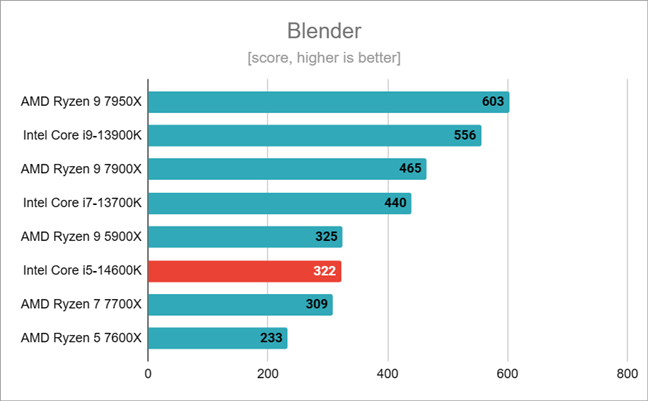
Benchmark results in Blender
To measure how well the CPU performs in everyday tasks like web browsing, video calls, office work, and digital content creation, I used the PCMark 10 benchmark tool. The Intel Core i5-14600K achieved an excellent result of 10449 points, which is comparable to the score I got with the more powerful AMD Ryzen 9 7900X. Unfortunately, the chart below only includes these two processors because I tested all the others with a different graphics card.
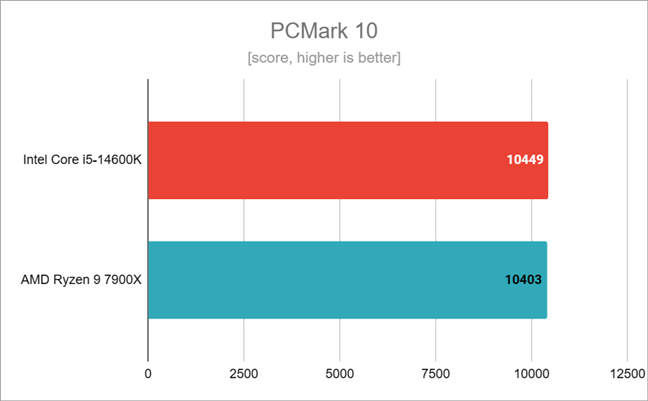
Benchmark results in PCMark 10
One of the most common tasks we all perform on our computers, whether we are gamers, content creators, or office workers, is web browsing. 🙂 To measure how well the Intel Core i5-14600K handles this task, I ran the JetStream 2 benchmark in Google Chrome. It achieved a score of 374 points, which is almost the same as I got with my main driver, the AMD Ryzen 9 7900X. Note that, just like for PCMark 10, I only included these two CPUs in the chart. The reason is that Google Chrome received significant updates since I’ve tested the other processors, and my “historical” results aren’t conclusive anymore.
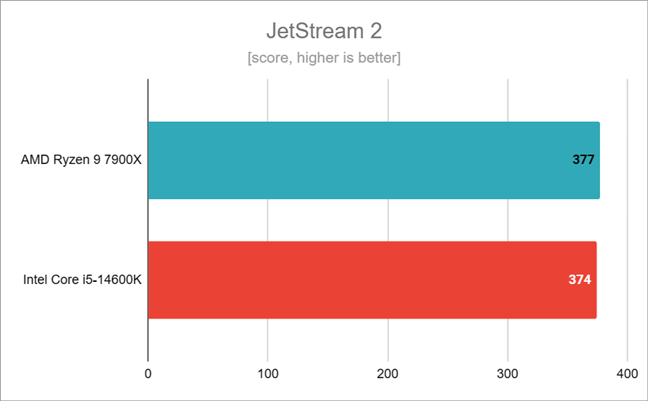
Benchmark results in JetStream 2
The Intel Core i5-14600K showed impressive performance in 7-Zip’s benchmarking tool, which is a good tool for indicating the processor’s power. It achieved a compression rate of 112 MB/s, which is significantly faster than AMD’s Ryzen 7 7700X mid-ranger. This test seems to depend on the RAM bandwidth: the Intel Core i9-13900K, which is more powerful, had a lower compression rate than the i5-14600K because I used DDR4 memory when I tested the former, not DDR5, like for the i5-14600K.
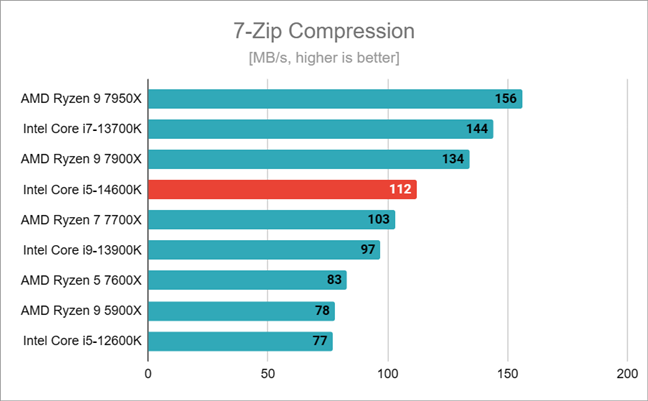
Benchmark results in 7-Zip Compression
In the decompression speed test from 7-Zip, the Intel Core i5-14600K ended up in the lower part of the chart. Though it got a good result, the lower number of cores found on this CPU doesn’t allow it to match the performance you get from an AMD Ryzen 7 7700X or an Intel Core i7-13700K, for instance.
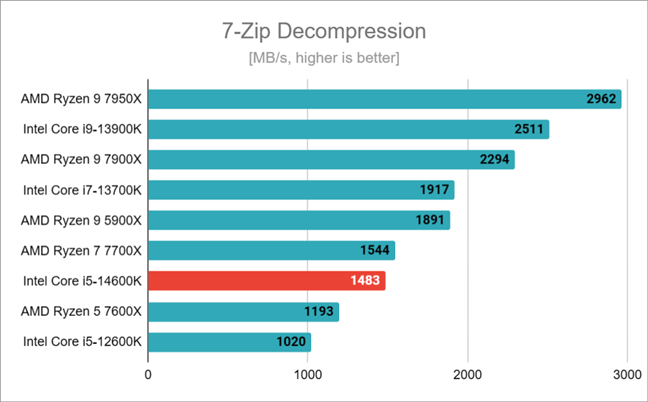
Benchmark results in 7-Zip Decompression
As these benchmarks demonstrate, the Intel Core i5-14600K offers plenty of performance and handles itself well in various workloads and applications.
Performance in gaming benchmarks
Let’s see how the gaming performance is. I used 1080p resolution and the lowest graphics settings to eliminate any possible GPU limitations. I also updated the list of games to include some of the latest AAA titles, such as Cyberpunk 2077, Starfield, The Callisto Protocol, and Total War WARHAMMER III. I couldn't compare the results with some of the older CPUs I reviewed before because I used different games or graphics cards for them. The gaming benchmarks below were done using an AMD Radeon RX 7900 XT GPU, the Intel Core i5-14600K CPU, and the AMD Ryzen 9 7900X CPU I use daily.
Cyberpunk 2077 is a demanding game, but it runs smoothly on the Intel Core i5-14600K processor. I tested it with this CPU and got an average of 245 frames per second (fps). This is a remarkable performance, especially compared to the AMD Ryzen 9 7900X. Though not far behind, the more expensive Ryzen 9 7900X couldn’t match the i5-14600K (4.70% fps increase for the latter).
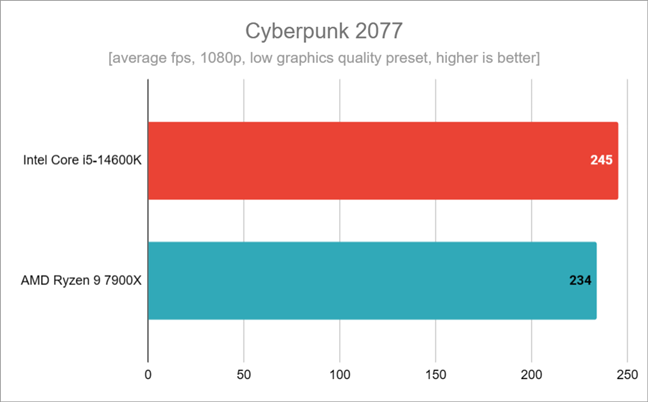
Benchmark results in Cyberpunk 2077
A comparison of the Intel Core i5-14600K and the AMD Ryzen 9 7900X in Starfield, a game that demands high performance from the hardware, showed no difference in the frame rates. Although I’ve set the game to run on the lowest graphical quality, it seems the GPU was still a bottleneck for my computer’s performance.
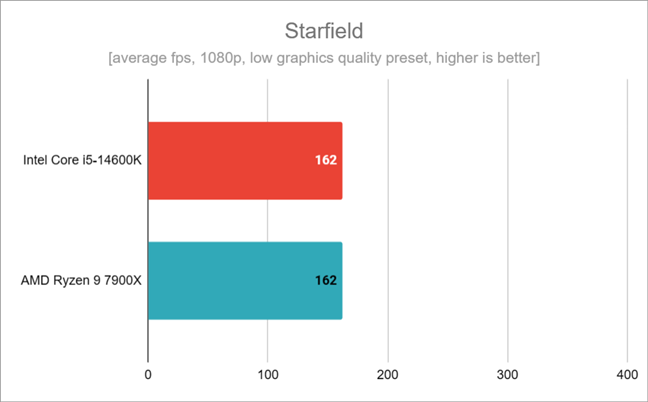
Benchmark results in Starfield
The Intel Core i5-14600K outperformed the AMD Ryzen 9 7900X by a noticeable margin (7.2% fps increase) in The Callisto Protocol. This shows that the Intel processor is more efficient and powerful for this game.
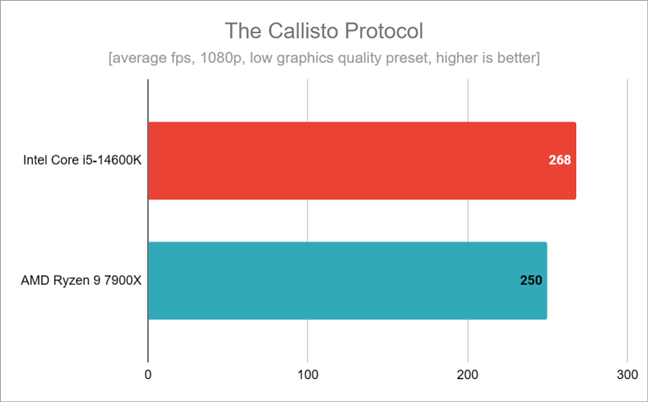
Benchmark results in The Callisto Protocol
In Total War WARHAMMER 3, the AMD Ryzen 9 7900X was once again unable to keep up with the Intel Core i5-14600K. The Core i5-14600 showed a 5.59% performance improvement over the Ryzen 9 7900X.
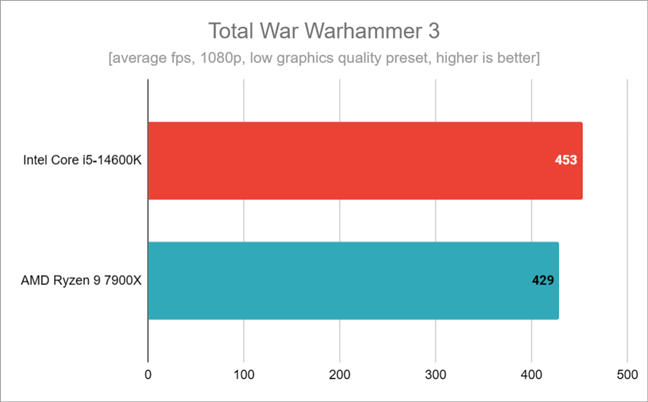
Benchmark results in Total War WARHAMMER 3
3DMark was the latest gaming benchmark tool I used. The results in the CPU Profile Max Threads test showed that the Intel Core i5-14600K is a good CPU for gaming, offering better levels of performance than AMD’s mid-range Ryzen 7700X or 7600X.
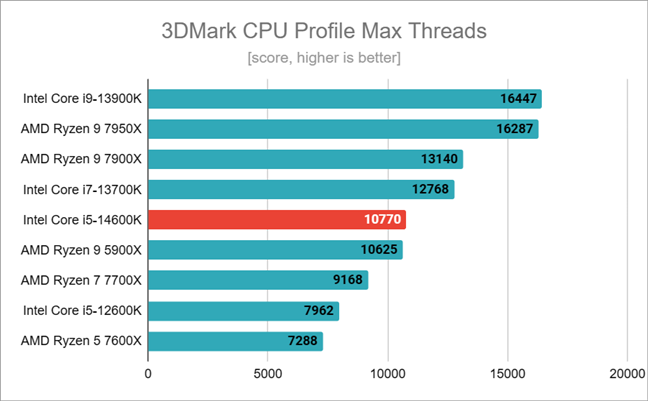
Benchmark results in 3DMark CPU Profile Max Threads
The Intel Core i5-14600K delivers impressive gaming performance in the games I tested, making it a great option for gamers. It can handle high frame rates for a reasonable price. If you already have a Core i5-13600K, it’s not worth upgrading. But, if you’re building a brand new PC, and your main purpose is gaming, the i5-14600K is a solid choice that won’t make you break your piggy bank.
Temperature and power consumption
To test the thermal performance of the Intel Core i5-14600K, I used Prime95 to stress the CPU. The highest temperature I measured was 84 degrees Celsius (183.20 degrees Fahrenheit). This is a reasonable temperature, but keep in mind that I had a powerful AIO cooling solution.
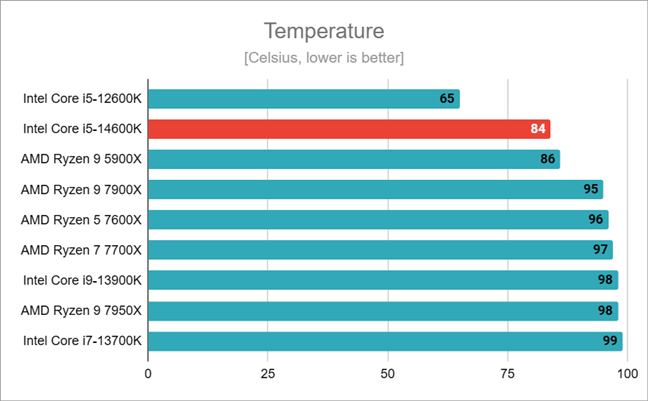
Temperature reached by the Intel Core i5-14600K
The official maximum power consumption of the Intel Core i5-14600K is quite high: 181 Watts. In my tests, it reached even more, going as high as 194 Watts! That’s quite a lot for a mid-range processor, and if there’s one thing I hold against this CPU, this is it. Compared to AMD’s mid-range CPU models, the ones from Intel, including the Core i5-14600K, are not energy-efficient at all.
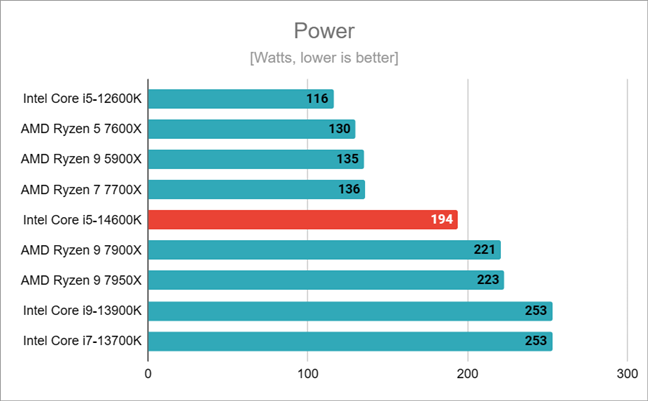
Power draw of the Intel Core i5-14600K
The Intel Core i5-14600K is not impressive in terms of power performance. The power consumption is much higher than what the AMD rivals need. As for the thermal requirements, the temperatures reached by the processor are not very high if you have a powerful cooling solution. I “warmly” 🙂 recommend using an AIO liquid cooler for it.
What’s your opinion about the Intel Core i5-14600K?
The Intel Core i5-14600K is a powerful desktop processor that delivers outstanding performance in games. It also fares well in most productivity workloads. If you are looking to build a new PC, you might want to consider this processor as a choice. If you’re thinking of upgrading your “old” 13th Gen Intel Core CPU, though, I don’t think it’s worth it, and you should probably wait for the next generation of Intel processors. What are your thoughts regarding the Intel Core i5-14600K? Let me know what you think in the comments section below.


 27.10.2023
27.10.2023 


